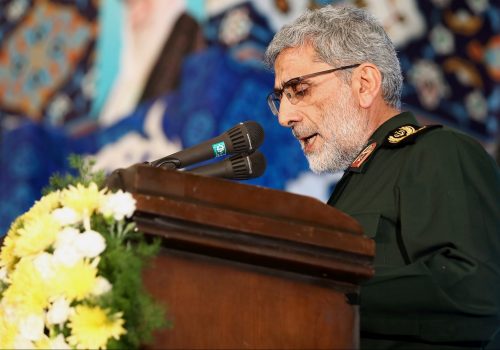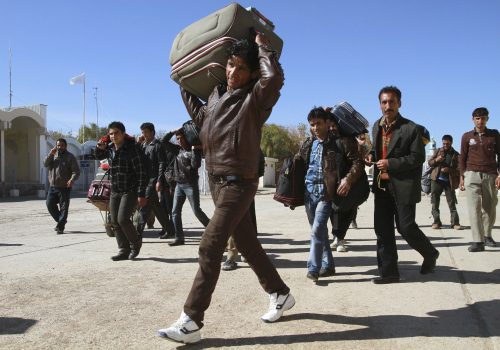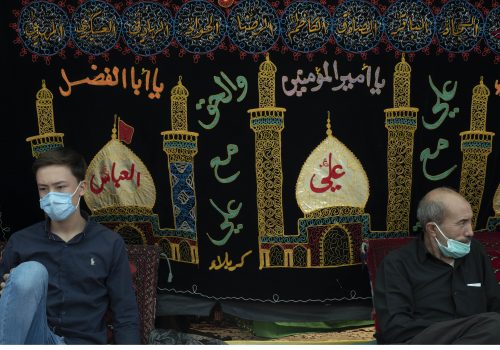My family was part of the US evacuation of Kurds in 1996. The US must do the same for Afghans.
With no paperwork and barely any money to survive on, my parents decided to leave everything behind in the Kurdistan Region of Iraq and seek refuge in America. They wanted to ensure my siblings and I a better upbringing than they had. My father, an ordinary man with a humble upbringing, was a translator for non-governmental organizations (NGOs) affiliated with the United States and coalition forces in the Kurdistan Region of Iraq. Following a heightened civil war in the region between 1994-1997, my father’s occupation placed our family in danger, as Kurds hired by the American-led coalition forces and NGOs were actively pursued and killed.
Luckily, my family escaped in 1996 through Operation Pacific Haven, the US Air Force operation that saved nearly seven thousand Kurds. Watching the tragic events unfolding in Afghanistan, I can’t help but think of my family’s own story. If it weren’t for Operation Pacific Haven, I would not be here right now sharing it.
Since the Taliban seized control of Kabul on August 15, tens of thousands of vulnerable Afghans are frantically seeking ways to depart Afghanistan, fearing for their lives under a Taliban regime. The International Rescue Committee estimates that there are three hundred thousand Afghans—such as translators and interpreters—who have assisted the US in the previous two decades, but that only 1 percent of them qualify for Special Immigrant Visas (SIV), thus, limiting their ability to flee the country. These individuals are now in danger of being targeted by the Taliban for collaborating with US and NATO-led forces, as the Taliban has reportedly already begun door-to-door manhunts to find these collaborators. Some have reportedly already been killed by the group during the past week. Furthermore, as reported by The Intercept, the Taliban has seized US military biometric devices that can potentially identify Afghans who assisted coalition forces, placing even more US-tied Afghans in harm’s way.
SIVs have been notorious for an excessive backlog in processing applications. Although there are three hundred thousand Afghans affiliated with the US, only sixteen thousand SIVs have been processed since 2014, with over eighteen thousand applications pending and thousands more ineligible. Adding to this mounting issue, advocates estimate that another fifty thousand vulnerable Afghans are also actively being targeted outside of the three hundred thousand US-affiliated Afghans. These include, but are not limited to, women, the LGBTQ+ community, human rights workers, journalists, women’s rights activists, and ethnic minority groups like the Hazara. With many Afghan citizens in danger and expressing an extreme desire to leave, the US must step up.
The US has the means and know-how to save Afghan lives with air evacuations as they have done previously through Operation Pacific Haven in the Kurdistan Region of Iraq and other campaigns, like Operation New Life in Vietnam during 1975 and Operation Open Arms in Kosovo during 1999.
How Operation Pacific Haven can inform evacuations in Afghanistan
Instead of leaving Kurdish allies on the ground, in 1996, President Bill Clinton gave the State Department approval for a voluntary evacuation, known as Operation Pacific Haven. This operation was swift and decisive, conducted in two phases: getting endangered Kurds to an intermediate safe area for screening before sending Kurds to Andersen Air Force Base in Guam, where they could safely evaluate and process the refugees before they continued to the US or other host nations.
Tying in the current Afghan situation to the Kurdish crisis of 1996, Washington has demonstrated the capability and know-how to protect at-risk refugees, transferring them to safety in a temporary location for processing and out of immediate danger. This model, however, is not solely relevant to the Kurdish context. The US has an opportunity to re-apply this evacuation strategy on a significantly larger scale in Afghanistan for locals who are potential targets of the Taliban but unable to leave quickly enough to escape danger due to an extreme backlog in SIV processing and visa requests. Some Afghans are even destroying documents for fear of reprisal from the Taliban. As stated by Congressman Ted Lieu (D-CA)—a US Air Force veteran who served in Operation Pacific Haven—the Kurds initially rescued had no paperwork. In the interests of prioritizing an escape from danger first and paperwork second, Operation Pacific Haven brought the Kurds to Andersen Air Force Base in the interim to allow time for processing while eluding the immediate threat by Iraqi President Saddam Hussein’s forces.
In 2015, Politico reported that the US has nearly eight hundred military bases in more than seventy countries and over ten international Air Force bases. Following the same strategy as Operation Pacific Haven, the US could first transport tens of thousands of Afghans to one of these sites for immediate protection. Once this foundational level of safety is established, relevant US personnel may support their processing and paperwork at these respective bases to speed up the screening process. Specifically, Operation Pacific Haven brought the Department of Health and Human Services to provide proper immunizations; Immigration and Naturalization Services to assist with applications; and the Federal Bureau of Investigation to prepare the refugees for emigration. As Afghans wait for their applications to process, they would be given a complete medical examination, learn basic English (if needed), and gain essential integration information, like the Kurds received during Operation Pacific Haven, which greatly aided their transition to life in the US.
Why should the US do this?
Washington has a moral obligation to save US-affiliated and vulnerable Afghans who are seeking refuge. Although the Pentagon announced its intent to provide relocation services to approximately 22,000 SIVs and their families, in addition to the activation of the Civil Reserve Air Fleet, as mentioned above, only 1 percent of the three hundred thousand US-affiliated Afghans qualify for SIVs, not to mention the many other at-risk communities. The Joe Biden administration’s current commitment of 22,000 SIVs is not aligned with other nations’ commitments, such as Canada’s and the United Kingdom’s, who plan to resettle twenty thousand vulnerable Afghans despite a much smaller population and host capacity. If the US committed on a similar proportion to Canada’s commitment, it would take in over 170,000 Afghan refugees. After twenty years in Afghanistan and over two trillion dollars spent, the US has invested too much to simply drop our allies and allow them to perish or be put at grave risk of human rights violations by the very group they have been fighting against for so long.
Veering away from the obvious moral obligation, the Biden administration must also consider its international reputation, as Washington is sending a message that discourages people of other nations from helping the US for fear of abandonment. Although remaking Operation Pacific Haven on the scale of Afghanistan’s situation would require serious money and human resources, the alternatives are bleak. Prominent organizations like Evacuate Our Allies and the Truman National Security Project have also argued that the Biden administration must follow an evacuation and safety first, paperwork second, approach.
The US has the capability and know-how to save countless Afghans through the framework provided by Operation Pacific Haven. President Biden cannot afford to bypass this opportunity. The world is watching.
Hezha Barzani is a program assistant with the Atlantic Council’s Middle East Programs.
Image: Iraqi Kurds and their families carrying their belongings walk through the Habur bridge to enter Turkey September 15 as they are evacuated from north Iraq. Most of the Iraq Kurds leaving, worked as employees of U.S. aid programmes and military groups. They began crossing the Turkish border September 15 at the start of an evacuation by pro-U.S. Iraqis who fear Baghdad's increased influence in northern Iraq. via Reuters


